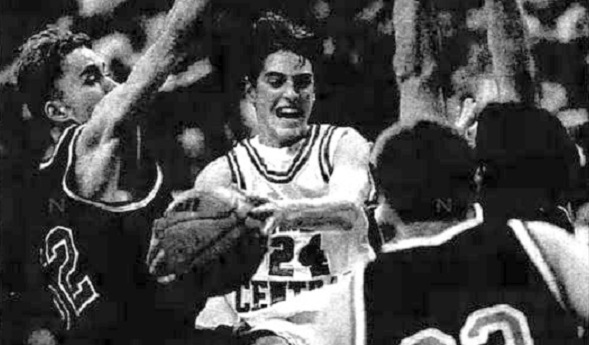
Hoops History Filled with District Stunners
By
Ron Pesch
MHSAA historian
March 9, 2018
The opinions expressed in the following are those of MHSAA historian Ron Pesch, and are not, necessarily, those of the folks who grant Pesch the chance to express them.
You are advised.
Life, sometimes, is unfair.
Despite healthy eating habits, lots of exercise, plenty of sleep, appropriate amounts of water, brain teasers, and blood pressure medicine – all those things that should, hopefully, extend a life – occasionally, our last breath arrives before the awarding of the gold watch or a trip to Disneyland.
The MHSAA Boys Basketball Tournament, sometimes, is like life. And that’s the way it should be.
The postseason is where all teams across the state are rewarded with a second chance, regardless of regular season win-loss record. In the thrilling one-and-done playoffs, highly ranked foes can be next-door neighbors or distant strangers; known only via rumor, newspaper rankings, or in these high-tech times YouTube clips. A knockout punch, ousting a team from the tournament, is most often delivered by a “worthy” opponent.
From time to time however, the end of the road arrives when least expected, via defeat by a less talented team vying for a cherished brand. “Underdog,” “Long Shot,” “Dark Horse” and “Cinderella” are the Nike®, Addias®, Reebok®, and Under Armour® of the unknown and under-achieving. Each brand is worn with pride. Everyone, including sportswriters, loves a sleeper.
In Michigan, with minor alterations, the MHSAA basketball postseason functions much as it always has operated. Champions are rare – by design, only four teams can finish the season with victory. Logistics and economics mean a team’s toughest opponent might arrive anywhere along the path. Districts are established based on schools of similar enrollment size found in logical geographic boundaries. District champions advance to play opponents in defined regions, and Regional winners move on to the final three rounds to determine those four statewide MHSAA champions. The state’s largest schools battle for the Class A title, while the smallest chase the Class D crown.
Therein lies the beauty. The playoff experience for today’s athletes is very much the same as it was for their fathers, their grandfathers and their great-grandfathers. The next opponent is luck-of-the-draw, based on a district line, and beyond a team’s control. Come game time, a blown breakaway, a bricked or air-balled jumper, or a rimmed shot that doesn’t fall can mean dreams of trophies, medals and glory, vanish from view. Tournament time does not discriminate. End game can happen to anyone.
Just like in daily life.
Sometimes, the toughest challenges arrive quicker than we feel they should. Within can be heartbreak, and, often, our greatest lessons.
Beware – the tournament tipped off again this week, and more than 120 District titles will be up for grabs tonight.
The MHSAA Tournament pre-dates Disneyland by 30 years. After assuming administrative control of high school sports in the fall of 1924, the Association made a move to expand the annual boys basketball tournament from three classifications to four with the addition of Class D in 1926.
Five years later, beginning in 1931, the public schools from the city of Detroit exiled themselves from the tournament. A year later, the schools in the Upper Peninsula did the same. Those moves, recent research shows, came from a general philosophy by local and national education authorities that there was an over-emphasis on competitive athletics. In the city of Detroit, the move meant a departure from statewide competition that would last for more than 30 years.
“The elimination of Upper Peninsula schools from state competition was the recommendation of its two (seats) on the (MHSAA representative) council,” came the report from the Lansing State Journal. “They deplored the long distances involved in sending teams from that section to the state tournament.”
Certainly, the depth of the nation’s Great Depression was a force that also insured distinct peninsula tournaments, at least in the earliest years of the separation. So, from 1932 through 1947, the MHSAA sponsored both Upper and Lower Peninsula tournaments, and crowned titlists on both peninsulas.
In 1941, and for nearly 20 years, the state’s smallest schools christened their own Class E champion. By far, the overwhelming majority were located in the vast Upper Peninsula, so it was a U.P.-only tournament.
Thereafter, a few twists of fate combined with population demographics to alter the shape of the event.
The number of schools, as well as their enrollments, played into the scheduling of action. For many years, Class A schools (as well as Class B schools for a few seasons), didn’t begin tournament play until the Regional round. Classifications were based on enrollment, with the state’s largest schools playing in Class A. Since there were relatively few Class A schools, when compared to Class C or Class D, fewer postseason games were required to identify a state champion for schools in the upper classifications. During the 1953-54 school year, there were 75 Class A schools, all in the Lower Peninsula. In Class B, there were 180 schools, (including 17 in the U.P.), while Class C included 246, (18 across the Straits). There were 181 Class D schools in the Lower Peninsula, (with 21 schools each in Class D and Class E in the U.P.). Hence, the path to a crown was, at least statistically speaking, more challenging for a smaller school.
With the post-war baby boom, and the growing size of the suburbs around the state, the first Class A Districts were held 60 years ago, in 1958. With that, the chase became more equal.
In 1961, for the first time, a Class A District tournament was held above the Straits. Played at Sault Ste. Marie, it included four teams, “with two U.P. teams, Sault and Escanaba, competing against two Lower Michigan quintets, Alpena and Traverse City,” according to the Ironwood Daily Globe.
In 1962, Detroit Public Schools ended their self-imposed exile and rejoined tournament play. With the return of those 20 schools, the first statewide prep tournament in 32 years now included 749 teams. Class A included schools with 900 or more students, Class B with between 400 and 899 pupils, Class C 200 to 399 and Class D for schools with enrollments of fewer than 200 students.
Beginning with the 2018-19 school year, basketball will move to divisions versus classifications, where the number of schools competing for a division title is uniform.
No. 1 Goes Down
Devastating District Defeats
It doesn’t happen often, but it does happen. Every now and then, Michigan’s top-ranked teams fall in the opening round of the MHSAA tournament.
1952 – Class C - Muskegon Western Michigan Christian 39, Muskegon St. Mary 36
Given little chance of surviving opening night Class C District play at Fremont High School, Muskegon Western Michigan Christian “had to do it the hard way, coming from behind with a last ditch rally that had the overflow throng on the edge of their seats.”
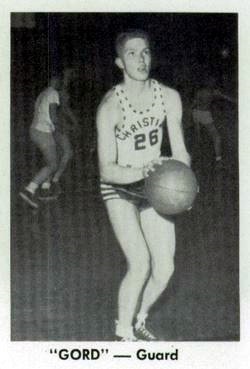 Twice beaten by St. Mary during the regular season, the Warriors opened a surprising 13-5 lead through the first quarter, behind the shooting of Gordon DeKruyter and Dave Bolema. The two seniors would end the game with high-scoring honors at 14 points apiece.
Twice beaten by St. Mary during the regular season, the Warriors opened a surprising 13-5 lead through the first quarter, behind the shooting of Gordon DeKruyter and Dave Bolema. The two seniors would end the game with high-scoring honors at 14 points apiece.
“I don’t remember much,” said the 83-year-old DeKruyter, laughing at the thought that Christian’s 39-36 victory over heavily favored Muskegon St. Mary was being recalled some 65 years later. “I’ve always thought it was hard to beat a team three times in a season. I guess that’s still the same today.”
“We had some real good contests in the old 4C Parochial League,” added DeKruyter. The league included Christian, and three Muskegon-area Catholic schools – St. Jean, St. Joseph and St. Mary. “We didn’t have our own gym back then, so we practiced on a short court at Muskegon’s Froebel School. Our coach, Elmer Wolcott, went on to win a number of state championships.”
Christian’s early lead, however, evaporated as the game quickly evolved into a real battle. St. Mary closed the gap to a point, 18-17, before the intermission, and then appeared to grab control of the game, 25-18, following the break.
“The game has seen quite a transition since those days of the set-shot,” said DeKruyter, who later played at Calvin College, then refereed for 27 years. “The biggest is the 3-point shot. It’s amazing how much it has changed the game.”
Another Christian rally knotted the contest at 31-31. The Warriors then grabbed the lead 35-33, but again lost it, trailing St. Mary 36-35 with two minutes to play. Bolema responded with a basket, and combined with a stop on St. Mary’s next possession, the stage was set for a stall by WMC for the victory. However, an errant pass, stolen with 18 seconds remaining, put the game on the line. In the vanishing seconds, filled with the pressure, intensity and noise of a win-or-go-home tournament March, St. Mary’s layup, likely separating victory and defeat, rimmed the basket and fell out.
DeKruyter snared the rebound and added an insurance basket just before the final whistle.
The celebration would last until the Regional Final. Along the way, WMC vanquished White Cloud, another surprise survivor of opening day District madness, by a point, and Lansing O’Rafferty by three, before falling by eight points to Holt.
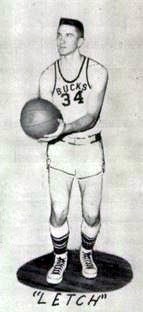 1955 – Class B – Buchanan 60, St. Joseph 57
1955 – Class B – Buchanan 60, St. Joseph 57
“It took two years but Jim Letcher got sweet revenge for a foul committed late in the district final in 1953 which gave the Bears a one point victory,” wrote Ed Lukas in the St. Joseph Herald Palladium. “Last night at the Buchanan gym, Letcher poured in 30 points to lead his Buck teammates to a 60-57 upset win over the highly touted St. Joseph Bears …”
The top rated team in Class B by the Detroit Free Press, St. Joseph had beaten Buchanan in both regular-season meetings. The winner of this matchup was expected to emerge as District champion. Indeed, Buchanan did just that, but barely, with a 47-45 win over Dowagiac. The Bucks rode the victories to the state finals, their first trip to the title game since 1928, before falling to River Rouge, 51-48, ending the year with a 17-7 mark.
1965 – Class C – Fowlerville 59, Portland 58
“Fowlerville, which did not have a winning record during the regular season, came up with the first major upset of the state high school basketball tournament Thursday night by edging previously unbeaten and top-ranked Portland, 59-58, in a Class C district … at Sexton,” wrote Ernie Boone for the Lansing State Journal. “Greg Braun, who only had six points all night and just one in the final period when Fowlerville took over the lead, sank a free throw with five seconds remaining to provide the winning margin.”
Fowlerville’s tournament run ended that Saturday as Williamston sank six free throws in the last two minutes of the District Final to emerge with a 48-46 win.
1969 – Class D – Detroit All Saints 62, Wyandotte Mt. Carmel 60, OT
“A perfect season and dreams of a state Class D basketball title went up in smoke Wednesday night before 3,000 fans for Wyandotte Mt. Carmel,” said Hal Schram in the Detroit Free Press. “Winner of 15 straight games and rated No. 1 among state powers in its division, Mt. Carmel bowed to old tormentor All Saints, 62-60, in a frenzied overtime period.
“Mt. Carmel has lost only three games in two seasons. All three losses came at the hands of the Saints.”
Detroit All Saints, reigning Class C state champ and ranked No. 3 by Schram, grabbed the District title before falling in the opening round of the Regionals to unranked Ypsilanti St. John, 65-62. Bob Sutton led all scorers with 21 for St. John in what was the upset of the tournament to that point. The Saints finished the year at 18-2.
1979 – Class A – Detroit Northeastern 95, Detroit Murray-Wright 91, OT
“Crash!! Murray-Wright High became the first big casualty of the 1979 state basketball tournament Tuesday night when the highly favored Pilots of coach George Duncan fell before underdog Northeastern, 95-91, in overtime at Highland Park High,” wrote Schram in the Free Press, describing the mayhem of the opening round to the District.
“Murray-Wright went into the game champion of Detroit’s Public School League and rated Michigan’s No 1 Class A team. But its 19-game winning streak ended when Joe Rodgers hit four straight free throws in the final 25 seconds of overtime to give the Falcons their most prized victory of the season.
“The Northeastern victory rubbed out another whirlwind comeback by Murray-Wright, which had to score 34 points in the final period to tie the game. … With 1:11 left in regulation, Northeastern led, 85-78, but the Pilots tied it with seven seconds left on Anthony White’s basket.”
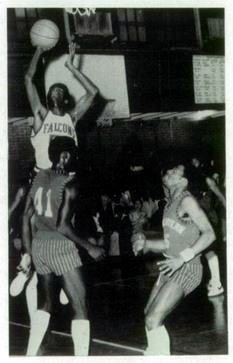 The likelihood of a rocky road to the title game for Murray-Wright was identified by Schram earlier in his write-up that accompanied his final regular-season ‘Top Ten’ rankings, a feature of the Free Press that dated back to the late 1940s. “There’s a dozen or so teams in Class A who could wind up with the big trophy. … Murray-Wright just might not get out of its own District where it has to meet and beat the likes of Northeastern, Highland Park or Northwestern.”
The likelihood of a rocky road to the title game for Murray-Wright was identified by Schram earlier in his write-up that accompanied his final regular-season ‘Top Ten’ rankings, a feature of the Free Press that dated back to the late 1940s. “There’s a dozen or so teams in Class A who could wind up with the big trophy. … Murray-Wright just might not get out of its own District where it has to meet and beat the likes of Northeastern, Highland Park or Northwestern.”
Much to the surprise of all the state’s prognosticators, unheralded Detroit Mackenzie, sporting a lackluster 13-7 regular-season mark, and preparing to celebrate its 50th graduating class that June, also got to celebrate its first basketball state title by downing Pontiac Central, 72-64, for the Class A crown.
1982 – Class C – Orchard Lake St. Mary 63, Redford St. Mary 55
“Orchard Lake St. Mary held off a late Redford St. Mary rally Monday night to defeat the No. 1 rated team in Class C, 63-55, in the first game of district play,” said Mick McCabe from the Free Press.
“Orchard Lake … jumped out to a 26-21 halftime lead despite the Rustics’ domination of the boards in the first half. Late in the third quarter, the Eaglets built up a 19-point lead but failed to deliver the knockout punch by missing a pair of wide open lay-ups before Redford scored the final five points of the period.”
Despite two losses – to Birmingham Brother Rice and Harper Woods Bishop Gallagher – The Associated Press and Detroit Free Press had ranked Redford St. Mary No. 1 in the state. With three losses – including a 79-77 defeat to Class A Detroit Cooley decided during the final 25 seconds – Orchard Lake St. Mary sat No. 2 in the Free Press’ final poll, while AP had the Eaglets at No. 4.
Orchard Lake led by 14 midway through the final frame, but Redford went on a 9-0 run to pull within five before running out of steam. Chris Howze scored 20 points on 8 of 12 shooting from the field to lead Orchard Lake to victory. Following the win, the Eaglets tore through Class C mostly uncontested until the Semifinals. Trailing by as many as 17 in the first half, Grand Rapids South Christian, a final four contestant in the previous two years, capitalized on the loss of Howze to fouls with 5:57 to play. Able to cut the margin to three with 21 seconds remaining, the Sailors couldn’t complete the furious comeback, and fell, 66-63. Orchard Lake coasted to the crown Saturday, thumping unranked Reed City, 76-48.
1995 – Class D – Detroit Holy Redeemer 75, Detroit East Catholic 66
“Hamtramck St. Florian will host the state’s second-best (opening round District) game when Detroit East Catholic (No. 1 in Class D) and Detroit Holy Redeemer hook up again,” noted McCabe in his pre-tournament column in the Free Press. “In the (Detroit) Catholic League semifinals, East Catholic got off to a huge lead against Redeemer and then hung for the victory.”
(The state’s top District opener, referred to by McCabe, ended as expected. Detroit Country Day, ranked No. 1 in the Free Press Class B rankings, rolled to an easy 55-48 victory over Orchard Lake St. Mary, the state’s No. 3 team. Sophomore Shane Battier scored 28, grabbed 11 rebounds and blocked three shots.)
McCabe had noted Redeemer’s senior guard Jimmy Reyes hadn’t played that well in the Catholic League final. Reyes certainly had his game in the rematch as he scored 20 points, including 13 in the fourth quarter, to lead the No. 6-ranked Lions to victory. Sophomore guard Armelius Parker added 17 as Holy Redeemer began its march to the Class D title.
The rivalry between the schools would continue in the coming years. Redeemer would again knock East Catholic out of the postseason in the District Final in 1996. East Catholic extracted some revenge in 1997, downing the Lions in the second round of the District, en route to its eighth and final MHSAA basketball championship. Both schools would close following the 2004-05 school year.
1997 – Class C – Benzie Central 73, Manton 70
In the opening game of the District 91 doubleheader, played at Benzonia, senior Nate Myers bagged eight 3-pointers, including the game winner with eight seconds remaining, as Benzie Central downed unbeaten and top-ranked Manton in the Class C District opener, 73-70. Benzie had lost an 11-point lead over the final four minutes.
“The gym was unbelievably full,” recalled Bill Lynch, a former coach at Benzie Central. “Just a great crowd. As I recall, Manton didn’t come down early to practice in the gym. I thought that was a mistake.”
Following the victory, Benzie Central cruised to the Semifinals before falling to Three Oaks River Valley in a frenzied 67-65 thriller. Trailing by 14, River Valley rallied back and was up three, 65-62, when Myers again bagged a clutch triple with just 11 seconds remaining to knot the game. But Zac Robinson would emerge as the game’s hero with a lay-up with 3.1 seconds remaining that hung on the rim “for an agonizing split second” before dropping through the net, ending Benzie Central’s dream run.
2004 – Class A – Grosse Pointe North 66, Detroit Denby 51
“Out of all the teams, that was the one team I was really concerned with,” said Detroit Denby coach Ray Reeves to McCabe about the draw of his team’s opponent prior to its Class A District opener with No. 9 Grosse Pointe North. “We beat them last year by 14, but it was a tough game. We made them play our style, and it wore them down.”
His concerns were warranted. Trailing by six to open the final quarter, North’s Mark Bramos scored 15 of his 25 points in the fourth as North toppled No. 1 Denby, 66-51, in Class A opening round District action.
“We saw them play Renaissance at Cobo, and that helped us a lot,” said guard Bryan Bennett, who scored 11 points for North. The Norsemen won the District, downing two more PSL squads Southeastern and Finney, but lost to eventual quarterfinalist Utica Eisenhower, 56-52, in their Regional opener.
 Ron Pesch has taken an active role in researching the history of MHSAA events since 1985 and began writing for MHSAA Finals programs in 1986, adding additional features and "flashbacks" in 1992. He inherited the title of MHSAA historian from the late Dick Kishpaugh following the 1993-94 school year, and resides in Muskegon. Contact him at [email protected] with ideas for historical articles.
Ron Pesch has taken an active role in researching the history of MHSAA events since 1985 and began writing for MHSAA Finals programs in 1986, adding additional features and "flashbacks" in 1992. He inherited the title of MHSAA historian from the late Dick Kishpaugh following the 1993-94 school year, and resides in Muskegon. Contact him at [email protected] with ideas for historical articles.
PHOTOS: (Top) Benzie Central’s Nate Myers drives between Three Oaks River Valley defenders in 1997. (Middle top) Muskegon Western Michigan Christian’s Gordon DeKruyter in 1952. (Middle) Buchanan’s Jim Letcher in 1955. (Middle below) Fowlerville’s 1965 team. (Below) Detroit Northeastern’s Joe Rogers puts up a shot in 1979. (Photos courtesy of Ron Pesch.)

#Charleytough Getting Stronger Amid Outpouring of Support
By
Tim Robinson
Special for MHSAA.com
March 11, 2021
On a recent evening at the home of Corunna boys basketball coach John “Rocky” Buscemi and his wife Chloe, the household is a whirlwind of activity.
 Their daughter Charley, 5, darts in and out of the Buscemis’ home office to ask questions, mimic riding a horse, or whatever else comes to the mind of a little girl full of energy.
Their daughter Charley, 5, darts in and out of the Buscemis’ home office to ask questions, mimic riding a horse, or whatever else comes to the mind of a little girl full of energy.
The only thing that would tell you that cancer had interrupted their lives for five months in the fall and winter is the hair that just now is starting to grow on Charley’s scalp.
Shock, then Support
Charley Buscemi is named after her grandfather, Charley Silm, who refereed high school basketball for 22 years in and around mid-Michigan when he wasn’t working on the farm. He often took his daughter, Chloe, to games he worked when she was a youngster.
“I remember packing up my little bag with snacks and watch my dad officiate,” Chloe Silm-Buscemi recalled. “Even though I didn’t play basketball, I grew up in the gym, just like Charley did.”
Her daughter has grown up watching her dad coach. She confidently refers to Corunna players as “her boys” and announces that she wants to coach with him some day.
Last summer, Charley was having trouble sleeping, and sleep apnea was diagnosed. Her doctor advised that removing Charley’s tonsils would likely eliminate the apnea.
 The Buscemis agreed, and her tonsils were removed Sept. 25.
The Buscemis agreed, and her tonsils were removed Sept. 25.
“We knew nothing else,” Chloe said, “but apparently the doctor noticed that one of the tonsils looked abnormal, or a little awkward, so he sent it off for testing.”
Chloe said she was told that any complications might require another operation to stop bleeding in the area, but she was stunned when the doctor’s office called back Oct. 1.
“We didn’t know the testing had been done,” Chloe said. “We got a call that said ‘the findings of the pathology are consistent with a diagnosis of lymphoma.’ And we were like, ‘Wait. What?’ It caught us completely off guard. (Charley) was racing in circles around our kitchen island and our dining room table, and I was like, no, you’ve got the wrong kid here. There’s no way this kid has cancer.”
“Initially, it was, this can’t be right,” Rocky said. “I was trying to read between the lines and find some wording that gave some idea that this is what they think. I tried to hang onto the idea that there’s got to be more tests, and those tests will show us that it’s not (cancer).”
The diagnosis was correct. Charley had diffuse large B-cell lymphoma, the most common type of non-Hodgkin lymphoma. It’s a fast-growing cancer that affects B-lymphocytes, a type of blood cell that helps fight infection.
While it is a fast-growing lymphoma, it’s considered potentially curable.
The cancerous cells found in Charley’s tonsil were sent to the Mayo Clinic and the National Institute of Health, and the diagnosis was confirmed.
Charley began chemotherapy at Sparrow Hospital in Lansing and celebrated her fifth birthday there.
Chloe, meanwhile, was also navigating the second trimester of her pregnancy.
“I spent most of my second trimester sleeping on a cot in the hospital while she got chemo treatments,” Chloe said.
“Her first round of chemo was horrible,” Rocky said. “She didn’t react to it well, and we were there 20 of 25 days.”
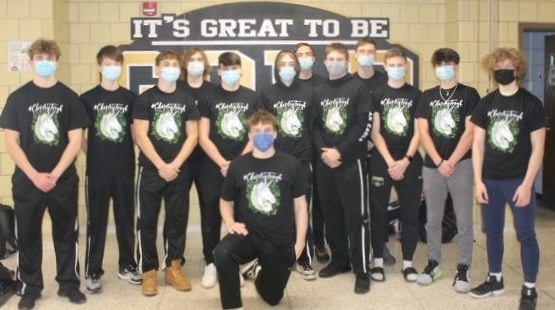 But once word got out, people in the Corunna school system, neighbors, fellow coaches and others reached out in the Buscemis’ time of need.
But once word got out, people in the Corunna school system, neighbors, fellow coaches and others reached out in the Buscemis’ time of need.
“The schools were so understanding,” Rocky said. “Once we found out, it was, go be with your family. Put in for your (Family and Medical Leave Act). Everyone was supportive from that end.”
The Corunna basketball players drove out to the Buscemi home and raked up its leaves. Some Corunna alumni got together to string up Christmas lights, the Orchard Lake St. Mary’s team sent her a giant stuffed panda, and many more showed support.
“We’re working on thank-yous now,” Chloe said. “My mom says people would know if you posted a thank-you (online), but I want to be able to send something out. Right now there’s something like 250 thank-yous.”
Strength & Sliver Linings
Charley had two rounds of chemotherapy and has been pronounced cancer-free. She has monthly meetings with her oncologist and quarterly CT scans scheduled for the next year.
“They’re watching her heart, because the chemo can affect that, so we meet with the cardiologist,” Chloe says.
“It’s a lot for a little person,” she adds as Charley flits back and forth between parents, announcing at one point she has cleaned her plate at dinner with no small amount of pride. “But for the most part, she’s just like this. She’s pretty happy, pretty easy-going, and takes it in stride. Sometimes I struggle with it more than she does. You feel totally helpless.”
For Rocky, the whole experience is full of silver linings, however hard-won.
“You’re always trying to find the silver linings,’ he said. “We had no idea she had cancer, but the silver lining was once we found out what it was, and it was confined to the tonsil, the blessing was it was almost a miracle we had her tonsils removed almost at the same time it was starting to develop. It wasn’t found anywhere else, so that’s a silver lining.
“Recently she’s been diagnosed as having celiac disease, and we’ve been given the OK to (shift) to a gluten-free diet. If she hadn’t had cancer, we might not have known until she was a teenager and had permanent damage. We’ve been so fortunate and blessed to find things out when we did.”
The Buscemis talk in tones of awe and appreciation for the caring and other gestures that have come their way.
“It’s incredibly humbling,” Rocky said. “It makes you want to do for someone else. I’m much more aware of people in need, and I hope to pay it forward. There are a lot of people you wouldn’t have anticipated reaching out who have reached out.”
The fear and stress of that time, he said, are often near, even with Charley in the clear.
“I wanted to be strong for Chloe and my family and be that rock that could be leaned on,” he said. “But man, oh man, there are still mornings when I drive to school and tear up. It’s nice to have other guys who understand that or have been through it. I’d be the rock here (at home) and then I’d be emotional with my friends in the coaching fraternity.”
Charley and 3-year-old brother Sam were mainstays at practice last year, playing quietly in a corner of the gym while the team practiced. Charley was at most every game, and Rocky always made a point of looking for her and her mother in the stands.
That hasn’t been the case this year, as Charley’s immune system has been weakened by the chemo and has kept her at home this season, watching the Cavaliers play on her mother’s laptop.
There’s been another change, too.
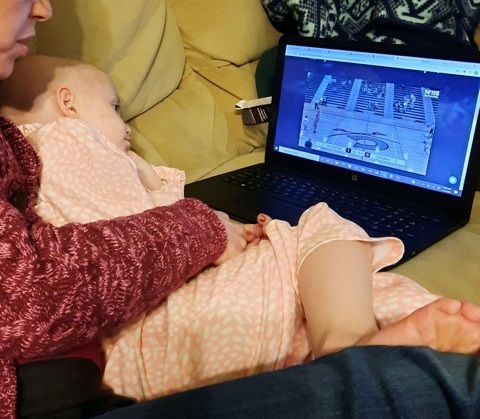 “I’ve adopted a one-day-at-a-time, appreciate-every-moment approach,” Rocky said. “A year ago in 9-degree weather, I might have been trying to find reasons not to go outside. Now if Charley wants to go sledding, we’re going sledding!”
“I’ve adopted a one-day-at-a-time, appreciate-every-moment approach,” Rocky said. “A year ago in 9-degree weather, I might have been trying to find reasons not to go outside. Now if Charley wants to go sledding, we’re going sledding!”
He laughs as he says that, a man who has a new appreciation of things.
His players have been honoring her, too, wearing black T-shirts at warmups with a large unicorn on the front with the hashtag #Charleytough and the Corunna logo on a basketball.
As for Charley, she will go back to kindergarten next year, but at the moment, she’s anxiously awaiting the birth of her brother or sister March 22.
She already has informed her parents that her new sibling will be a girl, named Maggie, and wants the newborn to sleep in her room.
“She says, ‘Mommy, I’ll feed the baby,’” Chloe said, chuckling. “I told Rocky we don’t have to worry about parenting a third baby. Charley’s got it.”
Besides another new brother or sister, if all goes well, Charley will be back on the sideline with her dad and her basketball team next winter.
Rocky says his family’s experience, among other things, showed him how strong the ties are in the coaching community.
“It was nice to see the game be the bridge that allowed me to reach out and depend on people a little bit,” he said “Without it, you don’t have those relationships. Things like this make you realize how special those things really are. If you don’t experience it, you don’t get to understand people’s true motivations.
“It was humbling,” he added. “It was scary at times, but all in all it was a little bit of everything that helped us to be able to get through this.”
PHOTOS: (Top) Charley Buscemi and her dad Rocky enjoy a fun moment at home. (2) From left: Charley, Rocky, Chloe and Sam Buscemi. (3) Corunna players wear #Charleytough T-shirts as warm-ups for their games. They prominently feature Charley’s favorite animal, a unicorn. (4) Charley’s immune system isn’t robust enough for her to attend games in person, but she never misses a chance to watch “her boys” play on her mom’s laptop. (Photos courtesy of the Buscemi family.)

